Why You Should Never Skip a Pre-Purchase Inspection in a Renovated House
When buying a renovated home, it’s easy to assume that everything is in top shape. However, skipping a pre-purchase inspection can leave you unaware of hidden defects that could lead to costly repairs. Even the best-looking renovations may conceal issues like poor waterproofing, faulty electrical work, or substandard construction.
Ironbark Building and Pest, servicing Brisbane’s northside, provides thorough inspections to help identify these hidden defects. This article explores why you should never skip a pre-purchase inspection on a renovated house, the common defects that can arise, and what to expect during the inspection process.
Why You Should Have a Pre-Purchase Inspection for a Renovated House
A renovated house might seem like a safer bet when it comes to purchasing a property, especially when it looks new and updated. However, skipping a pre-purchase inspection can lead to costly surprises down the line. Renovations are not always done to the highest standard, and defects may be hidden beneath freshly painted walls or new floors. Without a professional inspection, you could miss significant structural issues or hidden damage, like subsidence or water problems.
DIY renovations are particularly concerning, as not all homeowners adhere to proper building codes. Even if the renovation looks polished, it may not meet safety standards, posing risks to you and your family. Electrical wiring, plumbing, or waterproofing issues may not be immediately visible but could lead to expensive repairs in the future. A pre-purchase inspection ensures that any renovation work has been done correctly and reveals any concealed defects.
Common Defects for a Renovated House
Renovated homes often present defects that are not always obvious. A common issue is poor waterproofing, particularly in bathrooms where improper sealing can lead to water damage behind tiles and walls. DIY tiling is another frequent defect, as poorly laid tiles can cause uneven surfaces, leaks, and eventual water ingress. Bathrooms and kitchens are hotspots for such issues, especially if renovations were done by unqualified individuals.
Another defect commonly found in Brisbane homes is inadequate drainage following a renovation. For example, many homes are raised and built underneath without accounting for proper water flow, which leads to moisture buildup and water damage on the ground level. These defects can cause long-term damage if left unaddressed, so having a thorough inspection of a renovated home is critical to identify and rectify these issues before purchase.
What to Expect from the Pre-Purchase Inspection of a Renovated House
A pre-purchase inspection for a renovated home follows the same process to that of any property. However, inspectors will focus closely on the areas that have been altered or newly built. You can expect them to examine the structure for any visible or hidden defects, such as moisture damage, cracks in the foundation, or unsafe electrical work. The inspector may also look at potential issues in DIY areas, including patios, decks, and extensions, to ensure they meet safety standards.
The report provided will highlight any concerns with the renovation work, giving you a clear picture of the property’s condition. Even if no major defects are found, an inspection is still essential to verify the quality of the renovation. This peace of mind ensures you know exactly what you’re purchasing and helps prevent costly surprises down the track.
Contact Us
For more information on Brisbane’s northside inspections, contact us today!


